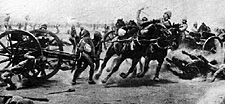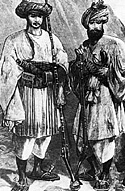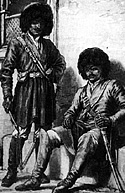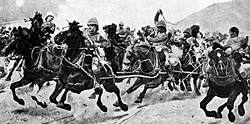 Burrows ordered Brigadier Nuttall to seize Mundahad. Nuttall sent
forward Major G. R. Blackwood the battery commander, with Fowell's
two guns and Captain Mayne's squadron of the 3rd Light Cavalry;
Maclaine's guns were left awaiting further orders. Blackwood soon
reported that Mundadad was unoccupied and orders were given for the
baggage train to be quartered in and around the village. Blackwood and
Fowell then crossed the dig nullah and advanced on to the plain. As they
did so Nuttall suddenly noticed that Maclaine had, without orders(?)
advanced at a gallop far out to the left flank, unlimbered und opened fire
on the Afghan cavalry at a range of ahout 1,700 yards. Nuttall
immediately ordered Fowell's guns into action at a point some 1,400
yards north of Mundabad, sent a trooper to recall Maclaine and
summoned up Osborne's guns from the rearguard to a position on
Fowell's right. Slade's smoothbore battery also came forward and went
into action from a position to the left rear of the Horse Artillery. Mayne's
squadron remained for the moment on the right flank while other c avalry
troops took post to protect the left flank and rear of the artillery. The
infantry meanwhile had advanced on to the plain and just before 11 am
were lying down some 500 yards behind the guns which were now all
engaging the enemy.
Burrows ordered Brigadier Nuttall to seize Mundahad. Nuttall sent
forward Major G. R. Blackwood the battery commander, with Fowell's
two guns and Captain Mayne's squadron of the 3rd Light Cavalry;
Maclaine's guns were left awaiting further orders. Blackwood soon
reported that Mundadad was unoccupied and orders were given for the
baggage train to be quartered in and around the village. Blackwood and
Fowell then crossed the dig nullah and advanced on to the plain. As they
did so Nuttall suddenly noticed that Maclaine had, without orders(?)
advanced at a gallop far out to the left flank, unlimbered und opened fire
on the Afghan cavalry at a range of ahout 1,700 yards. Nuttall
immediately ordered Fowell's guns into action at a point some 1,400
yards north of Mundabad, sent a trooper to recall Maclaine and
summoned up Osborne's guns from the rearguard to a position on
Fowell's right. Slade's smoothbore battery also came forward and went
into action from a position to the left rear of the Horse Artillery. Mayne's
squadron remained for the moment on the right flank while other c avalry
troops took post to protect the left flank and rear of the artillery. The
infantry meanwhile had advanced on to the plain and just before 11 am
were lying down some 500 yards behind the guns which were now all
engaging the enemy.
As these initial dispositions were being made, the mist suddenly
cleared and Ayub's army came clearly into view, wheeling off its line of
march and deploying into battle formation. On its left were swarms of
tribesmen, many of them religious fanatics known as Ghazis, supported
by some cavalry; in the centre were the regular Afghan infantry, seven battalions with three
in reserve; on the right the cavalry, already beginning to feel round the
British left flank; deployed at intervals along the line was the artillery. At
last Burrows realised what appalling odds his small force of 2,600 was
facing; his own estimate of the Afghan army was 4,100 cavalry, 5,900
infantry and about 15,000 tribesmen against his 12 guns the Afghans
mustered 30, which now began to come into action and open fire at a
range of about 2,000 yards.
As the great host of Afghans began to tramp southwards towards
Burrows' position, his three battalions marched forward and took up a
post on either side of the guns. On the extreme right the 66th, 15 officers
and 364 men; on their left four companies of the 30th NI, Osborne's two
nine-pounders, two more companies of the 30th and Fowell's guns; to
the left of these guns was the Sapper company, 45 men commanded by
Lieutenant Henn with one native officer and two British NCOs; next
came Maclaine's guns with on their left the smoothbore battery and
finally, on the extreme left two more companies of the 30th with only one
British officer, Lieutenant D. Cole. The cavalry were already busy on the
left flank demonstrating against the Afghan horse who were edging
further and further round to the rear and the baggage, where Major
Ready had disposed his small force to protect it. The baggage was also
threatened on the other flank as parties of tribesmen began to creep
down through the villages but accurate long-range rifle fire of Quarry's
G. Company 66th kept them off.
By now the hot July sun was beating down on the battlefield. In the
centre the Afghans were content to push steadily forward covered by
their artillery whose well-directed fire increased in intensity. To avoid
casualties the British infantry were ordered to lie down but the more
exposed cavalry and gunners began to suffer. To counter the threats on
the flanks, two guns of the smoothbore battery were sent to either wing
at about 12.15.
On the right, opposite the 66th, some enemy cavalry suddenly charged. Lieutenant Hyacinth Lynch later described this attack; "M'Math (his company commander) held his fire until they were
quite near, within one hundred yards I should say. Then he let them have a volley. Several fell, horses and riders mixed up in great confusion. Many closed with us but they had lost their formation and there was no shock. They came on and when within striking distance the horses
refused to face our bayonets and turning to their left, rode along our front pushing our bayonets to one side. The men on the knee and standing stuck at the men and horses as they brushed by. When they passed away to the flank we opened fire at the riders and horses on the ground in front of us and very soon disposed of them."
By one o'clock no Afghan infantry had attacked but while the
pressure on the British flanks and rear continued the Afghan artillery was
being pushed forward even closer to the line firing continuously. The
British gunners fought their guns manfully but the artillery duel was
hopelessly one-sided. The smoothhore guns on the flanks were brought
back to the centre put between 1.30 and 2 pm they ran out of
ammunition and Slade ordered them to the rear. Slade himself now had to take over E Battery as Blackwood was seriously wounded as was Fowell.
Coinciding with the withdrawal of the smoothbores, the Afghan
artillery was pushed forward again, first to within 700 yards of the line,
then 500. Now Ayub signalled his hordes forward. A mass of Ghazis
erupted from the smaller nullah and charged headlong at the 66th.
Springing to their feet the thin khaki line poured volley after volley into
the onrushing host. Hundreds fell and though the attack was pressed with
great courage, it melted away in the face of British musketry. To the right
of the Ghazis, the regular Afghan infantry advanced against the fire of the
two Indian battalions. To begin with the rifle fire did great execution and
Colonel Mainwaring commanding the 30th, afterwards reported: "I was
thrice enabled to give the order to cease firing consequent on the enemy
having been driven back".
Although the initial assault had been held Ayub's men came on again.
On the extreme left, the two companies of the 30th were in grave
danger. They had lost the support of the smoothbores, Lieutenant Cole
had been killed and their three Indian officers gravely wounded. As a fresh swarm of Ghazis bore down the sight of their yard-long knives and the sound of their terrifying yells
proved too much for the sepoys of the 30th. Seized by panic, they hurled themselves, as if for shelter, amongst their fellow sepoys of the 1st Bombay Grenadiers. That Regiment, which had hitherto behaved admirably, was thrown into confusion. Major Leach, VC, Burrows' staff
officer, saw what happened;
"Although every endeavour was made hy LieutenantColonel
Anderson and his officers to rally the men and to form a square, they
were by this time in a great measure out of hand and the officers could
only get the sepoys to form a sort of V ... at this juncture
Lieutenant-Colonel Anderson was hit in six places and ... the infantry
continued retreating without formation."
The infantry which had been to the left of the guns were making for Mundabad, whilst those on the right headed for Khig. Burrows personally tried to turn the latter towards Mundabad, but only succeeded with some of the 30th and part of the 66th. Most of the latter in small
rallying squares made for the deep nullah to the left of Khig. The sight of their wounded was terrible; fighting for their lives, the 66th were unable to carry them off and those that could not walk had to he left to be butchered by the Ghazis.
End of the 66th
At the nullah, the Commanding Officer of the 66th, Colonel James Galbraith, 47 years old and 29 of them in the Regiment, seized the Queen's Colour, rallied his remaining men and made a
determined stand. The afghans held off and opened a devastating fire, causing a further 60-70 casualties. The Colonel decided on a further withdrawal to the houses and walled gardens of Khig. As the men retired, firing as they went, the Colonel fell, still grasping the Colour.
Lieutenant and Adjutant Rayner was badly wounded and Private Darby, who in peacetime had been the Regiment's bass drummer stood over him firing and using his bayonet until he too was cut down.
About 100 men of the 66th reached Khig and there they stayed, firing what was left of their ammunition. The Afghans were content to pour in a heavy fire and gradually the remnants of the Regiment died. Major Blackwood who had stayed with the 66th though suffering from his wound, was killed here. 2nd Lieutenants Olivey and Honeywood died in succession holding up the Regimental Colour to rally the men. Finally it was taken up by the senior non-commissioned officer, Sergeant-Major Cuppage; he stood firmly for some time but eventually he and the Colour went down and neither rose again.
At last the end came. Only two officers, Lieutenants R.T. Chute of
the 66th and C.W. Hinde of the Bombay Grenadiers, and nine men of
the 66th remained standing. This little band formed up and charged out
of the gardens to the south-east. But wounds, thirst and exhaustion
brought them to a halt; they stood back to back and fired their last
rounds until they were all killed. Only when the last man fell, did the
Afghans close in.
All that remained of the 66th was a party retreating from Mundabad,
where they had held out for some time under the direct command of
Burrows, and Major Ready and the baggage guard. Throughout the day
Ready had beaten off repeated attacks until 3 pm, when the retreat
became general. He then attempted to withdraw the baggage covered by
G Company but as all the men were greatly exhausted by heat and thirst
he was compelled to abandon the stores and to retreat carrying the
wounded on the baggage animals.
"Quarry retired slowly, firing on the enemy as they pressed on. I saw
many (enemy) killed by good, steady shooting at 400 yards ... I
remained in rear and urged Quarry to come back and form up by the
guns. He was so done and sad that he said he would retire not any more
and wanted to go back to the gardens ... At about 5.30 I think the
enemy fired several round shot at us and I don't think they pressed
further".
The men of E Battery who joined up with Ready had conducted a
fighting withdrawal. Firing case shot at the enemy infantry, they held their
ground until the Afghan artillery got their range, when they limbered up
and moved off again. Of their conduct on this day, Burrows wrote
afterwards in his despatch: "Their behaviour was admirable, exposed to
a heavy fire they served their guns cooly and steadily as if on parade
and when the guns were rushed they fought the Ghazis with
hand-spikes and sponge-rods."
Acts of Gallentry
Individual acts of gallantry were later suitably rewarded. Trumpeter Jones received the
Distinguished Conduct Medal and Sergeant Patrick Mullane the Victoria Cross. As Mullane's gun was being hooked in, Driver Istead was struck from his horse. Looking back, Mullane saw
the man was still alive. Though the enemy were only a few yards off, the Sergeant ran back, lifted the wounded driver onto the limber and, mounting Istead's horse, brought the gun out of
action. Later on, during the retreat, Mullane volunteered to enter a hostile village alone and under fire to bring out water for the wounded.
Other wounded men owed their lives to Gunner James Collis, who was awarded the VC for engaging a party of Afghans single-handed, thus allowing his gun team with
its load of wounded men to escape.
Retreat
Throughout the retreat the guns served as a rallying point for the survivors. There were 40 miles to cover back to Kandahar, 16 of them across a waterless desert. Along the route
the news of Ayub's approach encouraged the villagers to attack the almost defenceless column. The horrors of the march were later described by Slade: "The guns and carriages are crowded
with helpless officers and men suffering the tortures of the damned; horses are limping along with ugly wounds and men are pressing eagerly to the rear in the hope of finding water ...
The cries of 'Water! Water!' become more frequent and louder and louder ... the wounded open their mouths and showed a dried, parched tongue."
All through the night and the next morning they staggered on until at about 2.15 pm the leading elements reached Kandahar after 33 hours of marching and fighting on little food, a scant supply of water, and in a temperature of 110 degrees in the shade.
Burrows was utterly crushed. In the words of an eyewitness, the defeated General, "worn out with anxiety, suffering and fatigue and voiceless with the strain of trying to keep his troops together, was, for the moment, a broken man". Out of his force of 2,600, 971 had been killed
or were missing, 168 were wounded; 786 followers were dead; 269 horses were killed and wounded and thousands of baggage animals lost; seven guns had been captured with quantities of stores and ammunition. At the time Maiwand was held to be the worst disaster to British arms in
Asaia since Chillianwallah in 1849. Only the gallantry of the 66th and the Royal Horse Artillery saved it from being a disgrace.
The repercussions were serious. General Primrose became besieged in Kandahar and the whole military situation in Afghanistan once again hung in the balance. Swift and decisive action was vital. On 9th August Roberts, with a force of 10,000, started on his epic march from Kabul
to Kandahar. Reaching the latter on the 31st, he relieved Primrose and the next day decisively defeated Ayub Khan outside the city. This victory ended the Afghan War but many problems on the North-West Frontier remained to be solved.
Postscript
One postscript to the story of Maiwand remains to be told. Among the survivors was the small white mongrel, shown in Feller's painting. This dog, Bobby, was the pet of Sergeant Kelly of the 66th. Although wounded in the battle, Bobby survived and rejoined his comrades in Kandahar. Returning to England with the Regiment in February 1881, he was decorated with the Afghan medal by Queen Victoria at Osborne in July of that year. It is sad to relate that, having survived the perils of Afghanistan, he was run over by a hansom cab in the streets of Gosport on 13th October 1882. His stuffed corpse can be seen to this day at the Duke of Edinburgh's Royal Regiment Museum in Salisbury.
'The Second Afghan War 1878-80; the Official Account' (London 1908). 1 In 1881 2nd Bn The Berkshire Regiment. Now The Duke of Edinhurgh's Royal Regiment (Berkshire and Wiltshire).
Back to Part I: Disaster at Maiwand This article appears in MagWeb (Magazine Web) on the Internet World Wide Web. At right, Afghan warrior infantry. Illustration from The Colonial Wars Sourcebook.
At right, Afghan warrior infantry. Illustration from The Colonial Wars Sourcebook.
 At right, Afghan cavalrymen. Illustration from The Colonial Wars Sourcebook.
At right, Afghan cavalrymen. Illustration from The Colonial Wars Sourcebook.
 The gunners of E Battery fought their guns to the last possible
moment; Maclaine's division, somewhat in advance of the remainder,
was overrun, cut down and lost their guns, but Slade managed to limber
up the other four when the Ghazis were within fifteen yards of the
muzzles and gallop off to a safer position (see right) in the rear where he again
opened fire. The small detachment of Sappers kept their heads and, as
the guns galloped off, they fired three volleys and marched steadily off in
formation towards Mundabad. As the triumphant Afghans hurtled
forward slaughtering the fleeing Grenadiers, the rest of the 30th panicked
and crowded down towards the right, falling upon the left and rear of the
66th. When the line started to collapse, Captain Beresford Pierse of the
66th had turned the rear rank of his company about and commenced
volley firing at the Afghans swarming round the captured guns; this fire
was now masked by the panic-stricken sepoys of the 30th, who
cannoned into the rear centre of the 66th, forcing the British soldiers
forwards towards the mass of Ghazis attacking in front. Their formation
disrupted, the 66th retired to the right, still preserving its cohesion and holding off the Afghans at ahout 25 yards range. Burrows galloped up to Nuttall and told him it was essential for the cavalry to charge. Nuttall and the British officers succeeded in forming up about 130 sabres but though they charged forward, the Indian troopers veered to the right hefore the moment of impact and retired off the field.
The gunners of E Battery fought their guns to the last possible
moment; Maclaine's division, somewhat in advance of the remainder,
was overrun, cut down and lost their guns, but Slade managed to limber
up the other four when the Ghazis were within fifteen yards of the
muzzles and gallop off to a safer position (see right) in the rear where he again
opened fire. The small detachment of Sappers kept their heads and, as
the guns galloped off, they fired three volleys and marched steadily off in
formation towards Mundabad. As the triumphant Afghans hurtled
forward slaughtering the fleeing Grenadiers, the rest of the 30th panicked
and crowded down towards the right, falling upon the left and rear of the
66th. When the line started to collapse, Captain Beresford Pierse of the
66th had turned the rear rank of his company about and commenced
volley firing at the Afghans swarming round the captured guns; this fire
was now masked by the panic-stricken sepoys of the 30th, who
cannoned into the rear centre of the 66th, forcing the British soldiers
forwards towards the mass of Ghazis attacking in front. Their formation
disrupted, the 66th retired to the right, still preserving its cohesion and holding off the Afghans at ahout 25 yards range. Burrows galloped up to Nuttall and told him it was essential for the cavalry to charge. Nuttall and the British officers succeeded in forming up about 130 sabres but though they charged forward, the Indian troopers veered to the right hefore the moment of impact and retired off the field.
Sources
Forbes, Archibald, 'The Afghan Wars 1839-42 and 1878-80' (Seeley 1892).
Hanna, Col. H.B. 'The Second Afghan War 1878-80' (Constable 1910).
Hensman, Howard. 'The Afghan War 1879-80' (W.H.Allen 1881)
Illustrated London News 7th August 1880.
Knollys, Lt. Col. and Elliot, Maj. 'Heroes of the Battlefield' (Manehester, nd).
Myatt, Frederiek 'The Royal Berkshire Regiment' (H. Hamilton, 1968)
Parry, D.H. 'Britain's Roll of Glory' (Cassell 1895).
Petre, F. Lorraine. 'The Royal Berkshire Regiment, Vol. 1' (Reading, 1925).
Swinson, Arthur, 'North-West Frontier' (Hutchinson 1967).
Tylden, Maj . G. 'E Battery, B Brigade, Royal Horse Artillery at. Maiwand') (J.S.A.H.R. Vol.
XLII No. 17).
Wood, FM Sir Evelyn, VC. 'British Battles on Land and Sea', (Cassell 1915).
NOTES
2 Burrows joined the Bombay Native Infantry in 1844. He commanded the 15th NI from 1867-72 but spent most of his service on the staff.
3 The 66th were only six eompanies strong, two being detached elsewhere in Afghanistan.
4 Col. H.B. Hanna, 'The Second Afghan War 1878-80'. The Official History says 1,400 regular cavalry, 5,000 regular infantry, 1,500 irregular horse, and 15-20,000 tribesmen.
Map: Disaster at Maiwand
Back to Colonial Conquest Issue 11 Table of Contents
© Copyright 1996 by Partizan Press.
Other military history articles and gaming articles are available at http://www.magweb.com